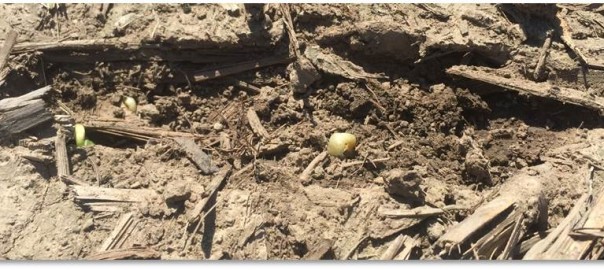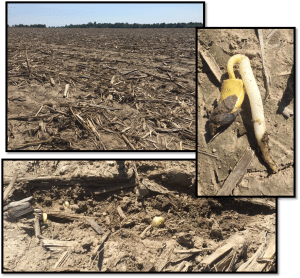- Evaluate the existing stand.
- Go to at least 10 places within the field and measure 1/1000th of an acre. For example, 13 feet, 9 inches is 1/1000th of an acre for 38-inch rows. (For other row spacings, see Table 1.) Once the appropriate length has been measured, determine which plants in the measured distance will survive or die. If the plant has severe lesions on the stem and the plant is brittle, it will probably die. If the roots are discolored but remain white or green when the brown tissue is scraped away, it will probably live. Also, examine the plant terminal. How do the new leaves look? If there appears to be new growth emerging, the plant may live. Cotton has a tremendous ability to survive if conditions favor growth. The seedling pictured here will likely survive given a light irrigation event or rain shower occurs within the following week- there are no signs of root rot or damage to the emerging seedling.
- Count the number of plants that are expected to live and multiply the plant number by 1000 to determine the plant population per acre. Research has indicated yields to be stable at populations between 20,000 to 70,000 plants per acre, but profitable crops can be produced outside this window. When determining if population is sufficient, consider yield potential of the field. Fertile, bottomland fields are better positioned to compensate for poor stands than eroded, droughty hills.
- Assess uniformity of the stand. Uniformity is arguably as (or more) important than population, since uniform plant populations as low as 1 plant per row-foot may be capable of producing a profitable boll load while inconsistent stands at much higher populations may result in very poor yields. Skips longer than 3 feet in length are of concern.
- Consider whether the whole field should be replanted or if it should be spot-planted. Spot re-planting, or ‘dropping in’, reduces seeding costs and time but may complicate crop management since several maturity ranges will be found within one field. If spot planting, try to block out parts of the field so that management inputs can be directed to larger areas. Most importantly, choose varieties whose technology traits and maturity will closely match the first planting or clearly identify these blocks and manage them separately.
- Consider calendar date. The optimal planting window for Tennessee is April 20-May 10. These dates are based on the probability of producing a profitable crop given long-term weather norms for TN. As planting dates move later into the season, this probability declines and risks increase. Subsequently, poor stands replanted on May 1 will likely be kept on May 25. Still, boll weevil eradication, Bt cotton and earlier-maturing varieties have helped to extend TN’s profitable planting window. It is not absurd to consider planting May twenty-something (possibly thirty-something) cotton given proper management techniques are used to emphasize timeliness. Keep in mind that setting a two-bale crop and harvesting that crop are two different things; an early freeze on an immature plant can be devastating.
- Consider costs and cultural practices. Currently, the decision most likely to lock acres into a keep or replant to cotton at late calendar dates is the use of a residual herbicide preventing a replant to soybeans. These herbicides include Cotoran®, Caparol® and Diuron®. Is the land leased or under a gin contract? Lease agreements may be crop-specific and offer no alternatives. Has fertilizer been applied? Another factor to consider is the possibility of having the technology fee waived.
- Is the weather forecast favorable for a replant? Destroying the planted crop and replanting in front of a large weather system may result in a less favorable position.
Remember that cotton has an uncanny ability to compensate for less-than-ideal stands and with a little luck, acres in question may produce a profitable yield. A common rule of thumb among most university Extension specialists is, “If the decision to replant is difficult, then there are probably enough plants to keep the stand.” After the decision is made, commit to it and do everything to ensure success.
Managing re-planted cotton
If the decision to replant is made, determine why the first planting failed and attempt to prevent the stress from recurring. Next, the old stand must be destroyed through tillage or herbicide. Given the large acreage of glyphosate/glufosinate-tolerant cotton, the most appropriate option will likely be 24-32 oz Gramoxone . Additionally, residual herbicides may need to be re-applied, as those applied at the time of the first planting may be close to playing out.
Manage for earliness. Choose an earlier-maturing variety with Bt technology. If the stand was lost due to disease, use the full rate of fungicide when replanting and try to plant beside the old row. The old furrow will contain disease inoculum and conditions for disease may be worse than the first time. Fruit retention will be crucial, as time may not allow for late-season blooms to mature. Overtop glufosinate applications to glufosinate-tolerant cotton should be made within the recommended window. Late applications will delay fruiting and maturity. In addition to early square retention, manage plant height with mepiquat chloride (Pix®, Pentia®, Mepichlor®, Mepex®, etc.) applications to control rank growth. Match the correct nitrogen rate to the realistic yield potential of the late-planted crop. Adding more nitrogen than necessary will delay maturity and increase the potential for damage from inclement weather.



